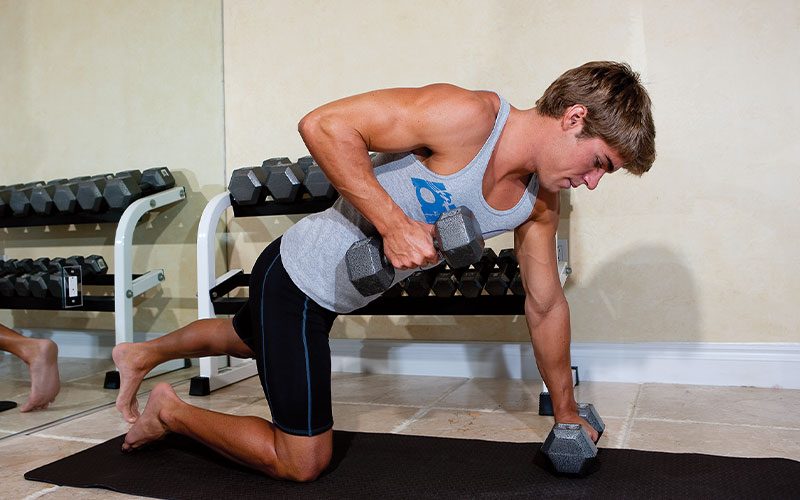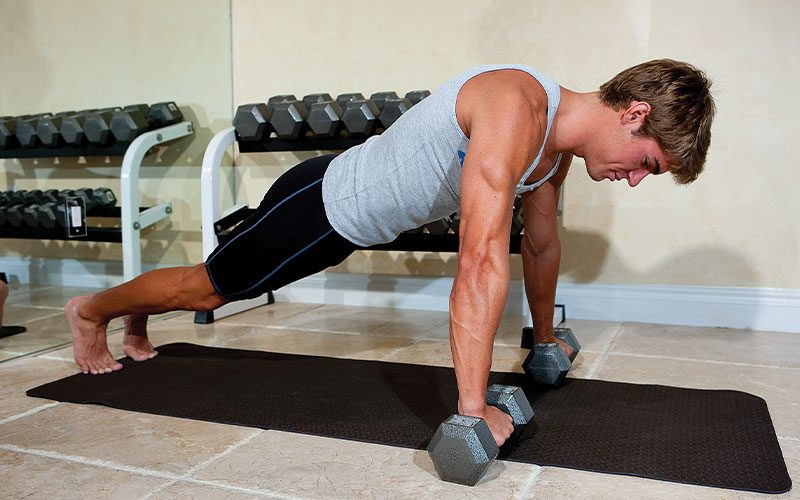Divers often overlook the importance of upper-body strength and endurance for safe and enjoyable diving. But think about it: The stronger your upper body, the easier you can lift gear, climb an exit ladder, pull yourself into an inflatable, carry tanks and even rise from a bench while donning scuba gear.
The practical exercises included here target the chest and the upper-back muscles that divers use most. They require minimal equipment, and you can perform them anywhere. They also activate the core abdominal and lower-back muscles, helping to build better balance and stability. All you need to get started are a pair of hexagonal dumbbells and a desire to be a stronger diver.
Achieving Balance with Supersets
In this fitness column, we address muscle groups in pairs to achieve overall fitness. For example, this upper-body plan addresses agonist/antagonist — aka reciprocal — muscle groups. All too often, people work their front (anterior) more than their back (posterior) muscles, creating imbalances in strength and range of motion that can lead to back pain. To achieve true fitness, it is important to balance your exercise routine.
Since divers benefit from overall fitness and stamina rather than body mass, this upper-body program is organized in what are known as supersets, a way of organizing muscle movements to provide optimal results in minimal time. The key to supersets is the forced balance between the agonist (working) and antagonist (opposing) muscle groups, minimizing waiting time while maximizing caloric expenditure. For example, during a push-up, the chest works while the back rests, and during the row, the back works while the chest rests. As each muscle group recovers, its opposing muscle group is in use. Thus, you continuously burn calories.
Think of it as a push-pull routine. In sequence, perform one each of the following exercises, then start the sequence over: one complete push-up; row left; row right. Repeat the sequence as many times as you can, then rest. Once you can complete 15 repetitions of the sequence, add challenges to the exercises. Remember to keep your core muscles engaged throughout the sequence by pulling your belly button toward your spine and maintaining a flat back as you perform the exercises.
Row

Start in the initial phase of the push-up. Then drop your right knee to the floor as you lift the dumbbell to your chest with your right hand. The knee will help you maintain balance. Slowly lower the dumbbell and raise your knee back to the starting position. Repeat on the opposite side. You will feel a greater pull on your abdominals on one side during this exercise.
Trainer Tips: A wider stance will help you maintain balance. Your ability to balance during this exercise will improve quickly because this adaptation is partially neurological. Neurological adaptations are how your brain creates a motor memory, identifying which muscle fibers to recruit to make a movement flow efficiently. Until these adaptations occur, movements will be shaky and inefficient, like trying to write with your non-dominant hand. If you still have difficulty, start with no weight then progress to light dumbbells (1-2 lbs.) Bring the dumbbell all the way to your chest with a twisting motion.
Challenge: Try the exercise with your feet together, then gradually increase the weight of your dumbbells.
Muscles Activated: The primary movers during rows are the latissimus dorsi, teres major and trapezius. You should also be engaging your rhomboids when you bring the dumbbell all the way up to your chest, squeezing your shoulder blade toward your spinal column. The posterior deltoid muscles are primary movers of the shoulder joint. You’re also working the biceps, triceps and anconeus, while your core muscles continue to work isometrically to stabilize your back.
Push-Up

The first phase of the push-up starts in the plank position, with both arms fully extended. This activates opposing abdominal and lower-back core muscles. Hold the hexagonal dumbbells directly under your shoulders. For balance, spread your feet slightly. Inhale, and flex your elbows until your torso nears the floor; then exhale while extending your elbows back to the starting position.
Trainer Tips: If you cannot yet complete five push-ups, start in a modified (half-plank) position supported by your knees rather than your toes. To stabilize your back, activate your core muscles by holding them in a fixed, tensed position. Focus on pulling your belly button toward your spine.
Challenge: Use a bench, stable chair or an exercise ball to elevate your legs. This increases the load supported by your upper body.
Muscles Activated: The primary movers during push-ups are the pectoralis and anterior deltoids of the chest. Your triceps and anconeus, which cross the back of the elbow joint, assist during the elbow extension, while your core muscles work isometrically to stabilize your back.
© Alert Diver — Q1 Winter 2010